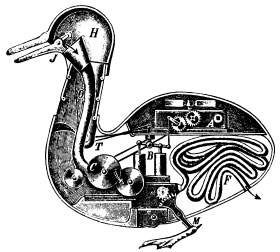Chapter 37: 371-381
Contents
Page 371
Amphibia
"plural of amphibian" – Wiktionary
Blanquette de Veau
Blanquette de veau is a French veal dish. The term 'blanquette' comes from the French word for "white" (blanc), being a ragout (stew) with a white sauce... In a typical recipe, pieces of veal meat (shoulder, breast) and aromatic vegetables (onion, celery, carrot etc) are simmered at length in water or stock. The vegetables may then be discarded and the cooking liquid is thickened and enriched with flour, butter, cream and egg yolks. Mushrooms, rice, pasta and potatoes are common accompaniments to this dish, which is served hot. From WIKI
Page 372
un Accés de Cuisinier
"an attack from the chef" -– HyperArts entry: French
or morely "the Approach of the Chef"? In other words, someone that shouldnt be in the kitchen, one would "deploy" this to get them out quickly (ie. stopped in their tracks)? Or on the otherhand, they may be sneaky with whomever it is to avoid the Chef, to keep them there.
Jacques de Vaucanson
Jacques de Vaucanson (February 24, 1709 – November 21, 1782) was a French inventor and artist with a mechanical background who is credited with creating the world's first true robots, as well as for creating the first completely automated loom. From WIKI
"He actually did make a mechanical Duck that could eat and excrete. Perhaps his most significant automata were his automatic looms, because years later, Jacquard would invent the punched card so as to program Vaucanson's looms" -- HyperArts entry: Vaucanson, Jacques de (1709-82)
See also, Bruce Mazlish’s the man-machine and artificial intelligence and Pynchon’s Is it O.K. to be a Luddite?.
Mechanical DuckThe Canard Digérateur, or Digesting Duck, was an automaton in the form of a duck, created by Jacques de Vaucanson in 1739. The mechanical duck appeared to have the ability to eat kernels of grain, and to metabolize and defecate them. While the duck did not actually have the ability to do this - the food was collected in one inner container, and the pre-stored feces was 'produced' from a second, so that no actual digestion took place - Vaucanson hoped that a truly digesting automaton could one day be designed. Voltaire wrote that "without [...] the duck of Vaucanson, you have nothing to remind you of the glory of France." ("Sans...le canard de Vaucanson vous n'auriez rien qui fit ressouvenir de la gloire de la France.") From WIKI
"an actual historickal figure; ‘account of the mechanism of an automaton, or image playing on the German-flute: as it was presented in a memoire, to the gentlemen of the Royal academy of sciences at Paris, by Vaucanson, inventor and maker of the said machine. Together with a description of an artificial duck, eating, drinking, macerating the food, and voiding excrements, pluming her wings, picking her feathers, and performing several operations in imitation of a living duck’ (Translated out of the French original, by J.T. Desaguliers. London, Printed by T. Parker, and sold by S. Varillon, 1742)" -- HyperArts entry: Duck, Vaucanson's mechanickal
See also Elaboration & Illustration, Great Chain of Being.
Page 373
Thousand Toises per Minute
Noun: toise, f. = a former French unit of length, corresponding to about 1.949 metres
Etymology: Old French teise (cognate with Italian tesa), from Latin tesa (brachia) ‘outstretched (arms)’, from tendere ‘stretch’.
Pronunciation: /twaz/
- a toise.
- a height gauge.
Retrieved from "Wiktionary"
This translates to approximately 72.66 miles per hour.
Man in the Iron Mask
"The Man in the Iron Mask was a prisoner held in a number of prisons, including the Bastille and the Chateau d'If, during the reign of Louis XIV of France. The identity of this man has been thoroughly discussed, mainly because no one ever saw his face as it was hidden by a mask of black velvet cloth, which later re-tellings of the story have said to have been an iron mask" -- Wikipedia
faison le Défeuner
"do lunch" -- HyperArts entry: French
